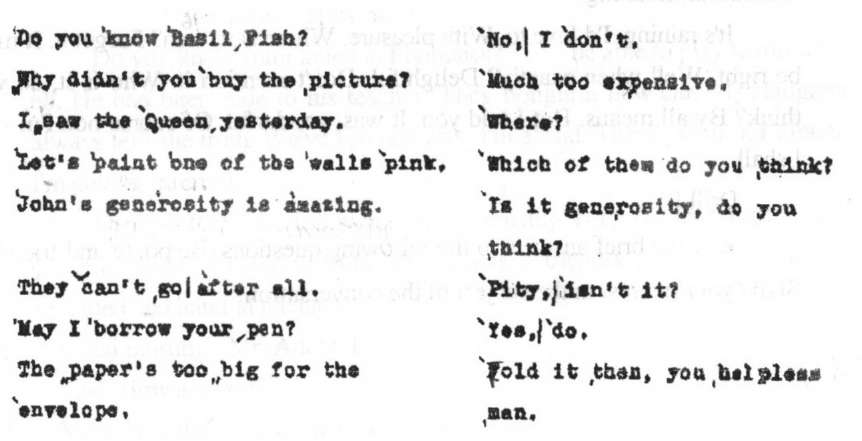
2.4. Tone Group III
TONE GROUP III
(Low Pre-Head+)(Low Head+) High Fall (+Low Tail)
Low Head: in the usual form of the low head, all the syllables contained in it are said on the same, rather low pitch. Before the high falling nucleus, the low head most often starts on a low pitch but rises gradually, syllable by syllable, to end just below the starting pitch of the nucleus.
Tone Group III is used with statements as definite and complete as those with Tone Groups I and II, but expressing rather a personal concern or involvement in the situation, sounding lively, interested, polite, friendly, airy.
When a Low Head precedes the High-felling nuclear tone, the attitude expressed is one of disgruntled protest, irritation.
Tone Group III is also used with lively and interested special questions. Statements and special questions with Tone Group III (and Tone Group IV) are particularly common in conversation.
Imperatives with Tone Group III show more warmth than with the previous tone groups, often connoting a critical surprise that such an obvious course should not have occurred to the listener.
Interjections with Tone Group III are rather emotional. Sometimes Tone Group III may occur with general questions. The reaction then is one of mild surprise but acceptance of the listeners premises.
Drill I. Listen carefully to the conversational situations. Concentrate your attention on the intonation of the replies. Repeat these sentences after the speaker:


Drill P. Read the following sentences using the intonation patterns of Tone Group III. Mark the intonation. Define the communicative type and the attitudinal meaning.
It’s raining. I'd love to. With pleasure. Where is it, then? Forget it. It must be right. Well when exactly? Delightful. Don't mention it. Who is it, do you think? By all means. But I told you. It was wonderful. Of course not. I'm sure 1 shall.
Drill III.
Give brief answers to the following questions. Be polite and friendly. Show your interest in the subject of the conversation.
Model: Who wrote "Twilight"? - Byron did.
Who wrote "Hamlet"? What language do they speak in France? What is the longest river in this country? How many months are there in the year? When is he coming?
Ask a question to make the task more precise. Try to be friendly and lively.
Model: Phone Tom. - Why?
Come and help me. Listen to the text. Tell him everything. Meet them at the station Discuss it with them. Give it up.
Tell your friend warmly how to cope with the situation. Express your surprise that such an obvious course should not have occurred to him.
Model: The desk is dirty, - Clean it.
The duster is dry. The button is not pressed. There is no chalk. The broth is not hot enough. The door is closed.
Drill IV. Reply to the following remarks in a polite and friendly way using "How terrible" or "How nice".
Model: He's broken his leg. - How terrible! I passed the exam. - How nice! Do you know John failed in Phonetics? We'll be able to play tennis after all. He had been rude to his teacher. They bought a new car. My daughter always tells the truth. We've lost our way, I'm afraid. There's steak for dinner. I'm getting married.
Drill V. Read the following dialogue using Tone Group III intonation patterns where necessary. Mind that this is a friendly conversation. Get it recorded and hand in the tape:
Good morning, Mr. Adam. How are you?
Fine. How are you?
Very well, thanks. Isn't this, weather lovely!
Beautiful. And hot.
But they say it’s going to rain to-night.
Oh.
Yes. It was on the radio.
Pity.
